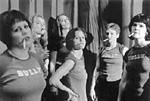A ROSE BY any other name might smell as sweet, but it sure would be hard to talk about. Words matter, names matter, and so when we come to the theater to see Amii LeGendre’s ensemble piece Bully, we know someone is going to get picked on. We’re just not sure who.
Amii Legendre
March 30-April 2 at On the Boards
When LeGendre made the work last year for On the Boards’ Northwest New Works series, the title came late in the process. Originally the dance was primarily about its music, by the rock group Violent Green, but in its current form it lives up to its name. Hazing, ragging, hassling, whatever you call it, Bully examines aggressive behavior.
LeGendre’s movement style is already very intense. Her background in gymnastics, combined with a wide range of modern dance genres, gives her work a kind of overall daring and a great facility with partnering. Like many of the high-risk companies we saw here in the 1980s and ’90s (Edouard Locke’s Human Steps and Ginette Laurin’s O Vertigo, for example), LeGendre’s choreography is fearless, plunging headlong into gut-wrenching sequences only to come out on the other side with a flourish. In Bully she pushes her dancers to exhaustion, giving the movement the rawness that comes with pure instinct.
It doesn’t take much to turn the volume up on those qualities and move into actual confrontation. Bully is like a playground writ large. The dancers shove and push, knock into each other in the way that might start as an accident but ends up as a fight. Adults usually realize that our culture doesn’t approve of this kind of behavior, so we frequently mask it or try to pass it off as a mistake. By the time we’ve arrived at a place where we don’t apologize for this violence, we’ve left many of our standard protections behind. When we see this sorry process in the theater, we’re uncomfortable, maybe a little indignant or smug. When the performers’ attention turns to us, we’re just scared.
With this series of confrontations, LeGendre hopes to draw attention to aggression as well as to stereotypes about gender and power. Running through the work is her concern about the actual process of seeing, the way in which a performer becomes an art object and the audience a consumer. She feels we’re not that far away from the time when a woman on stage was assumed to be a whore, and the men in the audience were, as she herself puts it, “gaga for girls’ bodies. I feel kind of hunted when I’m on stage.” The dancer is the prey and the audience the predator. “Being a female performer dealing with that gaze”—the look that can transform you from a person to a thing—is daunting, and for LeGendre at least part of the solution seems to be returning the look. So if the dancers try to bully the audience a bit, aren’t they just getting a little of their own back?








